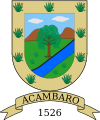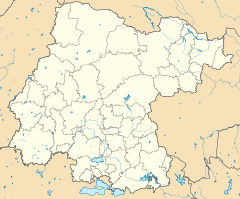Acámbaro facts for kids
Quick facts for kids
Acámbaro
Akambarhu
San Francisco de Acámbaro
|
||
|---|---|---|
|
City and municipality
|
||

Main plaza in Acámbaro
|
||
|
||
| Nickname(s):
The city of bread
|
||
| Motto(s):
With Acambaro, Guanajuato was born
|
||
| Country | ||
| State | Guanajuato | |
| Municipality | Acámbaro | |
| Founded | 1526 | |
| Signing of ratification | 1535 | |
| Founded by | Don Nicolás de San Luis Montañés | |
| Area | ||
| • City | 15.63 km2 (6.03 sq mi) | |
| • Municipality | 877.8 km2 (338.9 sq mi) | |
| Elevation | 1,860 m (6,100 ft) | |
| Highest elevation | 3,100 m (10,200 ft) | |
| Lowest elevation | 1,800 m (5,900 ft) | |
| Population
(2020 census)
|
||
| • City | 56,597 | |
| • Density | 3,621.0/km2 (9,378.5/sq mi) | |
| • Municipality | 108,697 | |
| • Municipality density | 123.829/km2 (320.715/sq mi) | |
| Time zone | UTC−6 (CST) | |
| • Summer (DST) | UTC−5 (CDT) | |
| Postal code |
38600–38787
|
|
| Area code(s) | 417 | |
| Website | City of Acambaro | |
Acámbaro is a city and municipality in the Mexican state of Guanajuato. It is located in the southeastern part of the state, along the Lerma River. Acámbaro is the oldest of the 46 municipalities of Guanajuato.
The name Acámbaro comes from the Otomi word Mä'wada. It was first a settlement of the Purépecha people. In 1526, the Spanish and their Otomi allies arrived. Acámbaro is known for its important railway history and for its famous "Acámbaro bread."
In 2005, the city had about 55,082 people. The whole municipality had 101,762 people. The municipality covers an area of 877.8 square kilometers (335.01 sq mi). It includes many smaller towns, like Iramuco and Parácuaro.
Acámbaro is surrounded by other places. To the north are Tarimoro and Jerécuaro. To the southeast is Tarandacuao. The state of Michoacán is to the south, and Salvatierra is to the west.
Contents
- Geography
- History
- What does the name Acámbaro mean?
- Who were the first people in Acámbaro?
- When was Acámbaro founded?
- What old buildings can you see in Acámbaro?
- How did Acámbaro grow in the 1700s?
- How was Acámbaro important in the Mexican War of Independence?
- What is Acámbaro's railway history?
- What are the Acámbaro figures?
- What other museums are in Acámbaro?
- What is Pan de Acámbaro?
- See also
Geography
What is the climate like in Acámbaro?
Acámbaro has a mild climate. It doesn't get too hot or too cold. The rainy season is usually from May to October.
| Climate data for Acámbaro | |||||||||||||
|---|---|---|---|---|---|---|---|---|---|---|---|---|---|
| Month | Jan | Feb | Mar | Apr | May | Jun | Jul | Aug | Sep | Oct | Nov | Dec | Year |
| Mean daily maximum °C (°F) | 24.1 (75.4) |
25.9 (78.6) |
28.3 (82.9) |
30.3 (86.5) |
30.9 (87.6) |
28.6 (83.5) |
26.5 (79.7) |
26.5 (79.7) |
26 (79) |
26 (79) |
25.6 (78.1) |
24.3 (75.7) |
26.9 (80.4) |
| Mean daily minimum °C (°F) | 5 (41) |
5.9 (42.6) |
8.5 (47.3) |
11.3 (52.3) |
13.5 (56.3) |
14.6 (58.3) |
13.7 (56.7) |
13.5 (56.3) |
13.0 (55.4) |
10.7 (51.3) |
7.5 (45.5) |
5.7 (42.3) |
10.2 (50.4) |
| Average precipitation mm (inches) | 15 (0.6) |
7.6 (0.3) |
7.6 (0.3) |
10 (0.4) |
41 (1.6) |
120 (4.8) |
180 (7.2) |
170 (6.8) |
130 (5.1) |
56 (2.2) |
13 (0.5) |
5.1 (0.2) |
760 (29.8) |
| Source: Weatherbase | |||||||||||||
History
What does the name Acámbaro mean?
The name Acámbaro comes from a Purépechan word. It means place of magueyes. Magueyes are large plants similar to cacti.
Who were the first people in Acámbaro?
The first people to live in this area were from the Chupicuaro culture. This was one of the oldest cultures in Mesoamerica. They lived here around 1200 B.C. Many valuable archaeological items, like ceramic pots, have been found here. You can see them in the local museum.
When was Acámbaro founded?
The city was founded on September 19, 1526. It was started by a leader named Don Nicolás de San Luis Montañés. He named it San Francisco de Acámbaro. This was the first Spanish town in what is now the state of Guanajuato.
What old buildings can you see in Acámbaro?
Franciscan friars helped to spread Christianity here. They also built many beautiful structures that are still standing. These include the Templo del Hospital (Hospital Temple). They also built an aqueduct in the Mudéjar style in 1527. An aqueduct is like a bridge that carries water. A stone bridge over the River Lerma was built in 1750. Acámbaro is special because it has a colonial-era aqueduct that is still complete.
The first bullfights in New Spain (colonial Mexico) happened in Acámbaro. A fountain in the city's plaza, called the Fuente Taurina, remembers this event.
How did Acámbaro grow in the 1700s?
The 18th century was a time of growth for Acámbaro. Many important religious and public buildings were built then. Several temples, bridges, and houses from this time show the city's colonial architecture.
How was Acámbaro important in the Mexican War of Independence?
A very important event for Mexican independence happened in Acámbaro. Don Miguel Hidalgo visited the city on October 22, 1810. He declared Acámbaro the military headquarters for the Ejército Grande de América (Grand Army of America). Hidalgo was given the title of Generalísimo de las Américas (Grand General of the Americas).
On that same day, a huge parade of eighty thousand rebels took place. This showed how fast the independence movement was growing. Just one month before, on September 16, only 800 men had joined the Grito de Dolores.
What is Acámbaro's railway history?
Acámbaro was very important for the development of railways in Mexico. It had a major railway junction, a yard, and a shop. These were for the National Railways of Mexico.
Acámbaro was home to the only large locomotive repair facility in Latin America. This facility could even build steam locomotives. In 1944, Acámbaro's workshop built La Fidelita 296. This steam engine is a symbol of that time for the people of Acámbaro.
La Fidelita is now on display at Acámbaro's railway museum. Another reminder of the steam age is a large model locomotive. It sits on a raised platform at a major highway intersection east of the city.
What are the Acámbaro figures?
Acámbaro is also known for the Acámbaro figures. These are a collection of about 32,000 clay figurines. They were found by German archaeologist Waldemar Julsrud in 1944. He found them near the Cerro del Toro (Bull Hill).
Some people believe these figures are fake. This is because some of them look like dinosaurs. This would mean that humans and dinosaurs lived at the same time. This idea is used by some to support creationism. Many of Julsrud's finds are now shown at the Museo Waldemar Julsrud.
What other museums are in Acámbaro?
Other interesting archaeological items are on display at the Museo de Chupícuaro. This museum is also known as Museo Fray Bernardo Padilla. It shows the history of the Chupícuaro people.
The Museo Local de Acámbaro has over 4000 items. These items are related to local Mesoamerican cultures. The Museo Local also has paintings about colonial Mexico and the war of independence.
What is Pan de Acámbaro?
Pan de Acámbaro (Acambaro bread) is the city's most famous food. It is a type of bread that looks similar to Jewish Challah. The largest bakery making this bread is Tio Sams. They claim to have invented it.
See also
 In Spanish: Acámbaro para niños
In Spanish: Acámbaro para niños




